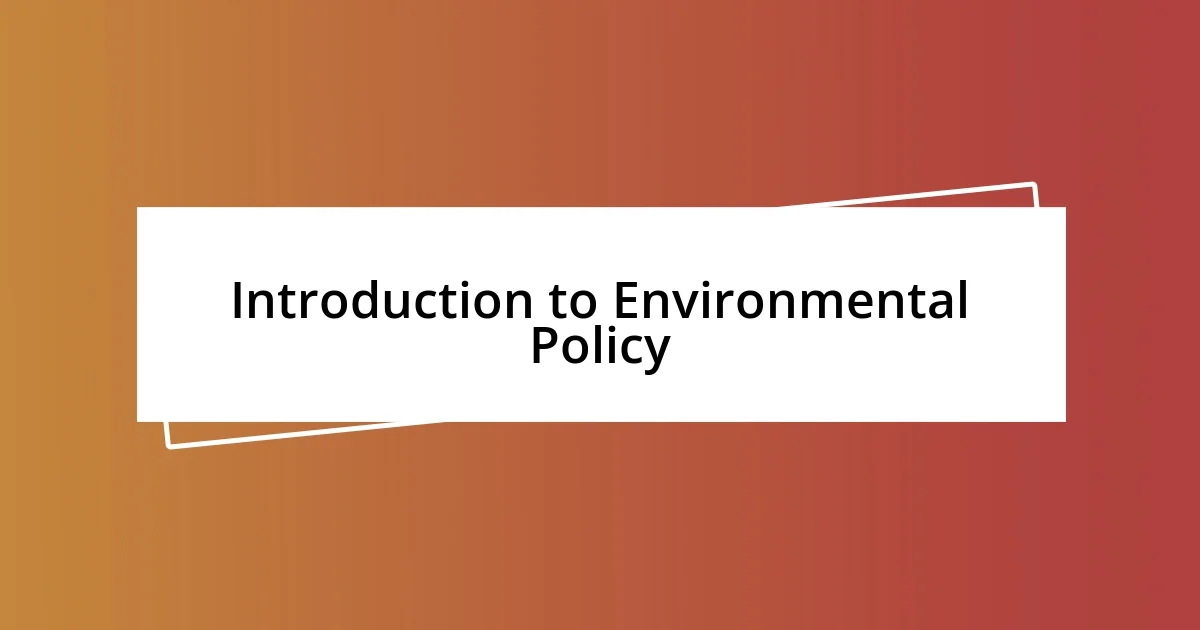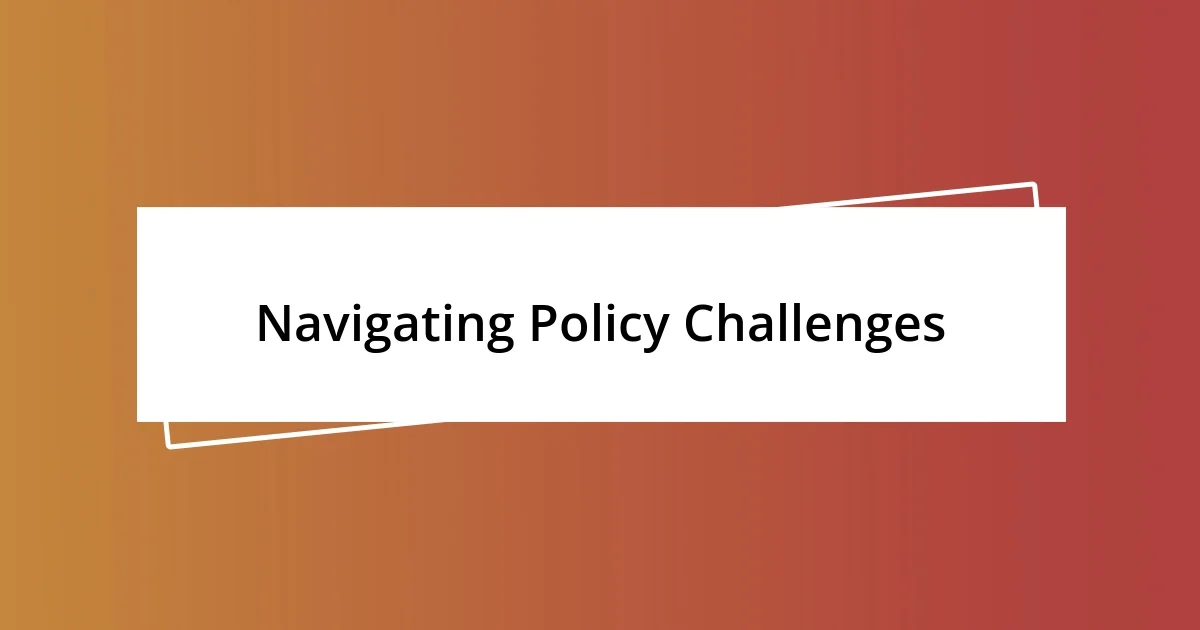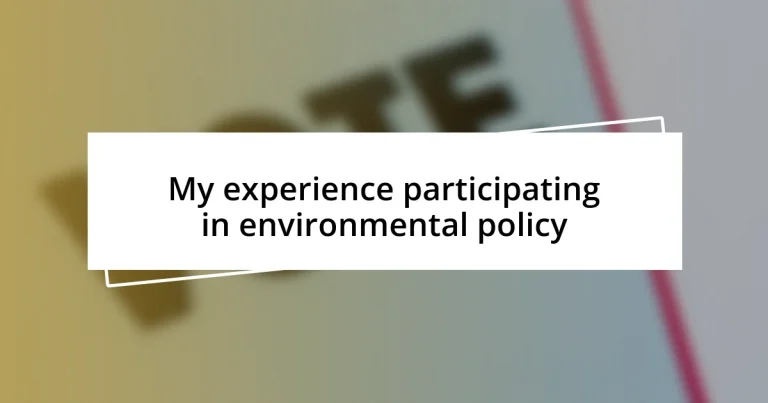Key takeaways:
- Participating in local initiatives highlighted the interconnectedness of environmental policy with economics and social justice, emphasizing that individual actions can inspire collective change.
- Engagement with communities during discussions and workshops showcased the importance of diverse perspectives and personal stories in shaping environmental policies.
- Future goals include leveraging technology for sustainability and fostering grassroots education to empower communities in environmental advocacy.

Introduction to Environmental Policy
Environmental policy is essentially the framework that guides how we manage our natural resources and address issues like pollution and climate change. I remember attending a local town hall meeting where community members passionately discussed the impacts of nearby industrial activities. It struck me just how much our environment shapes our daily lives, and it’s enlightening to see that policies are created to safeguard the very air we breathe.
When I first delved into the world of environmental policy, I was surprised to find out how interconnected it is with economics, social justice, and even health. It feels overwhelming at times; isn’t it intriguing how one decision can ripple through so many facets of society? This interconnectedness is what makes environmental policy not just a bureaucratic necessity, but a vital aspect of our collective future.
What’s fascinating is that environmental policy is not just for lawmakers; it invites everyone to participate, from businesses to individuals. I recall volunteering for a local initiative aimed at reducing plastic waste, and it opened my eyes to how grassroots efforts can influence policy at larger scales. This personal involvement reminded me that we all have a role to play in shaping the policies that protect our planet.

Understanding Environmental Issues
Understanding environmental issues is crucial for fostering meaningful discussions about policy. I vividly recall a moment at a community workshop where we brainstormed solutions to water pollution affecting our local river. I found it eye-opening to see how the pollution didn’t just stem from one source; it involved multiple factors including agricultural runoff, industrial waste, and even urban development. This experience heightened my awareness that environmental issues are often complex, involving various stakeholders, and thus require collaborative solutions.
One memorable conversation I had with a mentor revolved around the impact of climate change on vulnerable populations. Learning that these communities often bear the brunt of environmental changes ignited a passion in me to advocate for equity in environmental policies. It made me realize that understanding these issues isn’t merely an academic pursuit—it’s about ensuring everyone’s voice is heard and valued. Isn’t that something we should all strive for?
Additionally, I’ve noticed that gaining a clearer understanding of environmental issues can significantly shift our perspectives. For instance, when I transitioned to using sustainable products, I initially felt like just one person making a small change. However, seeing my friends and family become inspired to take action themselves showed me the power of personal choices in shaping a collective mindset. Advocacy can start small, but it has the potential to create a ripple effect in our communities.
| Environmental Issue | Example |
|---|---|
| Pollution | Affects air and water quality, directly impacting health. |
| Climate Change | Vulnerable populations face the greatest risks. |
| Resource Management | Involves balancing consumption with conservation. |

My First Steps in Policy
When I took my first steps into the world of environmental policy, I approached it with a mix of enthusiasm and trepidation. I remember attending a workshop where the speaker shared how local legislation could significantly affect community resources. It was fascinating to witness firsthand how seemingly small policy changes could create domino effects, shaping the environment and lives of countless individuals. This realization sparked a desire in me to dive deeper and understand the mechanics behind these policies.
- Attended a town workshop focused on environmental regulation.
- Engaged in conversations with community leaders about policy impacts.
- Realized the importance of understanding how laws shape local landscapes.
- Found inspiration in the stories of those directly affected by environmental changes.
I can’t shake the feeling I had when I first connected with other passionate individuals at a local advocacy group meeting. The energy in the room was electric, filled with people eager to make an impact. One person shared their personal experience regarding the struggle for clean air in our community, which deeply resonated with me. That moment marked a pivotal point in my journey; it made me realize that policy isn’t just about rules and regulations—it’s about real lives and the urgent need for change. The stories shared that day became a powerful motivation for me to get involved.

Engaging with Local Communities
Engaging with local communities has been one of the most fulfilling aspects of my journey in environmental policy. I fondly recall a neighborhood gathering where we discussed our park’s declining health. When residents shared personal stories about their childhood games in that same space, I realized how deeply people connect to their environment. Isn’t it incredible how shared experiences can galvanize action?
During another event, I facilitated a session on air quality that attracted a range of community members, from schoolchildren to retirees. As we mapped sources of pollution together, the unity in that room was palpable. Each voice contributed valuable insights, reminding me that everyone has a stake in the conversation. I couldn’t help but think—how often do we miss out on these collective moments of enlightenment?
Moreover, I’ve participated in clean-up drives, and the camaraderie among volunteers always astonishes me. I remember one day when a young girl picked up a piece of trash and shared how it made her feel like a superhero. That simple moment reinforced my belief in the power of grassroots engagement. When we come together to tackle environmental challenges, it creates a ripple effect of empowerment and awareness. How can we not feel inspired by that?

Collaborating with Environmental Organizations
Collaborating with environmental organizations has opened up a wealth of opportunities for me to learn and contribute. I remember the first time I joined forces with a nonprofit dedicated to habitat restoration. The excitement was palpable. We spent an intense day planting trees together, and I was struck by how our collective efforts could create a tangible impact. It’s powerful to witness diverse individuals coming together, sharing their expertise and passion for the environment.
Working with established organizations has also given me valuable insights into effective advocacy. Just recently, I participated in a campaign to raise awareness about plastic pollution. In our planning meetings, the deep discussions about strategies and messaging opened my eyes to the complexities of communicating environmental issues. I couldn’t help but wonder: how can we craft narratives that truly resonate with people? I took notes, inspired by the idea that a well-told story can ignite change.
I’ve found that collaboration often leads to unexpected friendships and connections. For example, during a joint event with another organization, I met a marine biologist who shared captivating stories about ocean conservation. Hearing about their hands-on experiences made the issue feel so much closer to home. Isn’t it incredible how partnerships can ignite passion and introduce us to perspectives we might never consider on our own? Each interaction deepens my commitment and reminds me of the shared responsibility we all have toward our planet.

Navigating Policy Challenges
Navigating policy challenges in environmental initiatives is often an intricate dance of compromise and collaboration. I vividly remember my experience attending a town hall meeting where we discussed proposed regulations for industrial emissions. The tension in the room was palpable, as differing viewpoints clashed. At that moment, I thought, how can we bridge these divides to foster constructive dialogue? It became clear to me that patience and active listening are essential tools in these conversations.
During my journey, I’ve faced moments where I felt overwhelmed by the sheer complexity of policy frameworks. One particularly vivid instance was when I tried to untangle the legislative jargon surrounding sustainable development goals. I spent hours deciphering a dense report, only to find myself wondering, are we overcomplicating our approaches? This reflection led me to advocate for clearer, more accessible communication strategies, ensuring that everyone can participate in these critical discussions.
In another encounter, I coordinated a roundtable discussion between local stakeholders and policymakers. Creating a safe space for everyone to share their thoughts was a challenge, yet it reinforced my belief in the power of diverse perspectives. As I watched differing opinions transform into a unified vision for our community’s environmental future, I couldn’t help but ask, how often do we underestimate the importance of inclusivity in policy-making? It was a powerful reminder of the impact we can have when we navigate these challenges together.

Reflections and Future Goals
Reflecting on my experiences, I often find myself pondering the emotional highs and lows of engaging with environmental policy. I recall a particularly moving moment during a community cleanup event. As I picked up trash along the riverbank, I encountered a family who shared stories about their favorite fishing spots, now threatened by pollution. It struck me how deeply these issues affect lives, sparking my determination to advocate not just for policies but for the people and ecosystems at stake. Isn’t it amazing how personal stories can fuel our passion for change?
Looking toward the future, I’m excited about setting new goals that prioritize innovative solutions in environmental advocacy. I’m eager to explore technology’s role in sustainability, like how data analytics can help track pollution levels in real-time. The thought of using cutting-edge tools to inform policy decisions is thrilling! I often ask myself: how can we leverage advancements in technology to create a more informed public? The possibilities feel endless, and I’m committed to playing a part in this evolution.
I’m also motivated to build stronger community ties through educational initiatives. I remember a workshop I organized where local youth created posters about climate change. Their enthusiasm was contagious and reminded me of the profound impact grassroots education can have. What if we could empower more communities to take charge in environmental advocacy? This vision of collaboration inspires me to develop more workshops and social media campaigns, aiming to foster a sense of ownership in the next generation. It feels like a journey worth pursuing!














